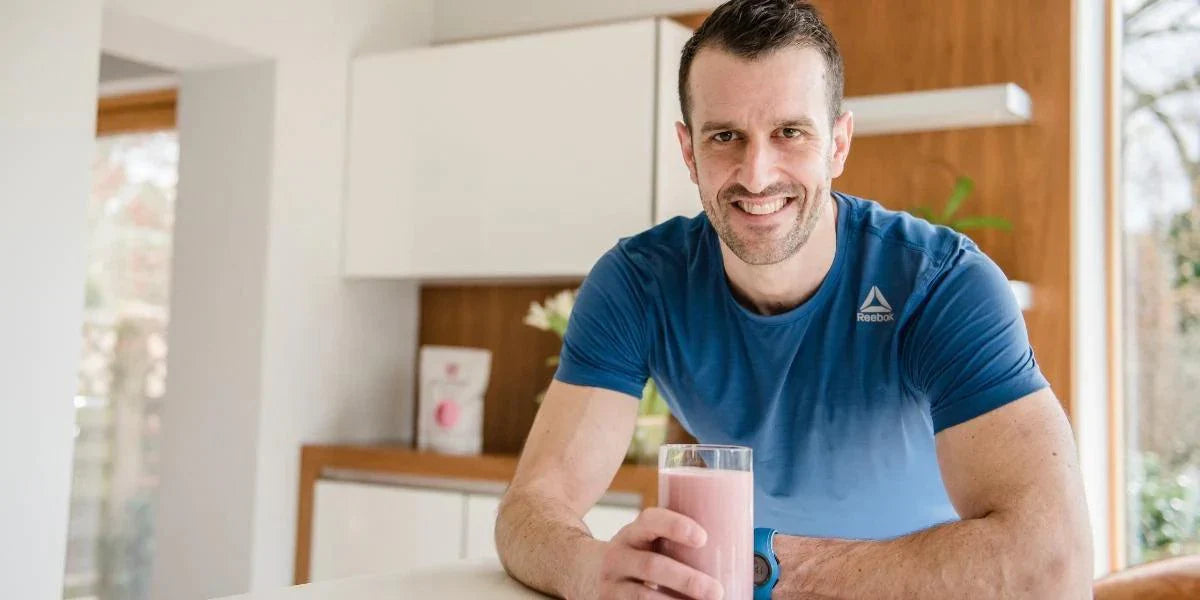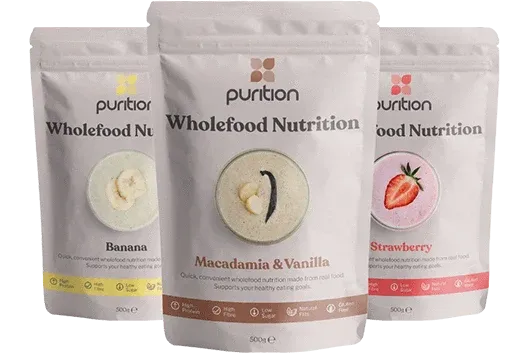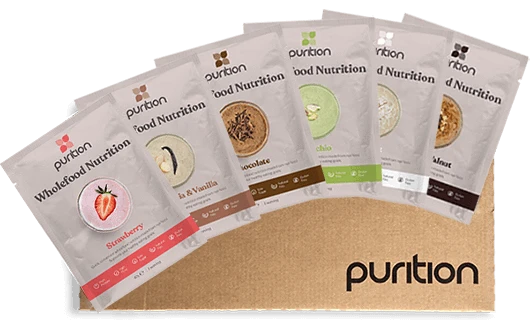If you’re stumped on how to increase your protein intake without spending extra hours in the kitchen, our 9 tips on how to eat more protein have you covered.
Looking to drive a healthier weight, get stronger or simply feel healthier? Protein will be your new best friend. Protein builds muscle, keeps your hunger in check and strengthens your hair, skin and nails. Pretty powerful stuff.
But actually packing more of the good stuff into your routine can feel easier said than done. Especially if you struggle to find time to cook meals from scratch or have recently gone vegan.
So here’s everything you need to know to sneak more protein into your everyday diet – quickly and conveniently – and feel way better for it!
Benefits of increasing your protein intake
- Reduces your appetite: In studies, a high-protein diet has been shown to increase the levels of three appetite-reducing hormones and reduce ghrelin levels (a hormone that makes you feel hungry). Protein also takes longer to digest than carbohydrates, so it can keep you feeling fuller for longer.
- Helps you to burn more calories: When you eat protein, 20–30% of the calories you consume are burned during digestion. This is significantly higher than carbs (5–10%) and fat (0–3%).
- Increase muscle and strength: In a 2012 study, two groups followed a low-calorie diet. One group ate larger amounts of protein than the other. Both groups lost around the same amount of weight, but the higher protein group preserved significantly more lean muscle mass.
- Improves your sleep: Studies show that eating a serving of protein before you go to sleep is linked to higher sleep quality.
Find out more in our high-protein diet guide.
How to increase your protein intake
These 9 simple steps will help you to supercharge your protein intake, which could help you to feel fuller for longer and, if combined with exercise, build muscle:
1. Prioritise protein at every meal
One of the easiest ways to get more protein into your diet is to simply make it a priority at every single meal you eat.
If you’re tracking your nutrition, this could be as simple as splitting your daily protein target into 3 (or 4, if you’ll be including high-protein snacks), then making sure to reach that figure with every meal.
If tracking isn’t for you, that’s okay. Just try to include at least a palm-sized serving (but ideally two) of a high-protein food at breakfast, lunch and dinner.
2. Know your protein sources
You can’t increase your protein intake without knowing your high-protein foods! Switch it up between animal and plant-based proteins if you can – a varied diet is a healthy diet!
Meat, fish & dairy
- Chicken breast
- Turkey breast
- Steak
- Pork tenderloin
- Tuna
- Salmon
- Cod
- Eggs
- Greek yoghurt
- Cottage cheese
- Purition Original
Vegan
- Tofu
- Tempeh
- Seitan
- Lentils
- Edamame
- Beans
- Chickpeas
- Nuts & seeds
- Soy milk & yoghurt
- Nutritional yeast
- Purition Vegan
3. Increase your protein portion size
The easiest way to increase your protein intake? Power up your portion sizes.
If you eat 1 egg at breakfast, eat 2. Tend to cook 2 chicken breasts for 2 of you? Cook 3 and have 1.5 each instead. Normally split a block of tofu between 4? Split it between 2 next time.
By increasing your portion size slightly at each meal, you can significantly boost your protein intake without any extra effort.
4. Choose a high-protein breakfast
Traditional British breakfasts like toast, cereal or breakfast bars might be convenient, but don’t typically pack in much protein. Switching up your breakfast to include high-protein foods could instantly help you to increase your protein intake by 15g+ every day.

Need some inspo? Try these easy high-protein breakfast ideas:
Non-vegan
- Greek yoghurt bowl with nuts, seeds & berries
- 2–3 scrambled eggs with veggies
- Frittata or omelette with cheese
- Protein pancakes made with eggs & Purition
- Purition Original as a shake, yoghurt bowl or porridge
Vegan
- Soy yoghurt bowl with nuts, seeds & berries
- Scrambled tofu on multi-seed toast
- Protein porridge (aka proats)
- Chia seed pudding
- Purition Vegan as a shake, yoghurt bowl or porridge
The best part? A high-protein breakfast will make you feel fuller for longer and prevent the dreaded mid-morning slump caused by high-carb breakfast sugar crashes.
Find more ideas in our high-protein low-carb breakfast guide.
5. Factor protein into your meal prep
If you've got no protein sources in the fridge after a busy day, your protein quota is bound to slip. As with any diet goal, the best way to increase your protein intake is to be prepared.
Why not have a protein meal prep session once a week? You can prepare and cook extra portions of protein, like lean chicken, fish, egg and spinach pots, boiled edamame beans or baked tofu, and keep them stored in your fridge for the week ahead.
That way, if you've got a busy day, you've always got an effortless source of protein to add to your lunches or dinners.
6. Add high-protein toppings to meals
No matter what you’re having for lunch or dinner, scattering a couple of tablespoons of seeds, nuts or nutritional yeast over your plate is an easy way to pack in more protein. It adds flavour and crunch, takes minimal effort and, by doing it at each meal, could easily add a welcome 10g+ of protein to your day.
Here are a few easy options to try:
- 2 tbsp nutritional yeast: 10g
- 20g pumpkin seeds: 8.6g
- 20g hemp seeds: 6.5g
- 20g chia seeds: 6.2g
- 20g flax seeds: 8.4g
- 20g almonds: 10g
- 20g peanuts: 5.2g
- 20g pistachios: 4.2g
- 20g sunflower seeds: 4.2g
- 20g walnuts: 3g
7. Enjoy protein-powered smoothies
On days you’re in a rush or have enjoyed low-protein meals (it happens!), smoothies are a good way to top up your protein intake quickly and conveniently. Plus, if you use the right ingredients, they could bank you 20g+ of protein in a single glass.
If you’re having a smoothie in place of breakfast, try to include protein, healthy fats and fibre to ensure you’ll remain full and fuelled for the day ahead. You can learn more about the types of ingredients to include in our guide to making a healthy smoothie.

But if you’re enjoying a smoothie as a protein-boosting snack, your priority should be to include high-protein foods, such as:
- Scoop plain protein powder: ~20g
- 40g Purition: 15–20g
- 200g silken tofu: 14g
- 150g Greek yoghurt: 9g
- 150g soy yoghurt: 7.5g
- 2 tbsp natural nut butter: 6–8g
- 3 tbsp chia seeds: 6g
- 2 tbsp pumpkin seeds: 5g
8. Eat your protein first
Did you know that protein can reduce your appetite? This is, in part, because protein naturally decreases your levels of the hunger hormone ghrelin. This is great if you're trying to lose weight or struggle with cravings – but not so great for your protein target if it means you can't finish your whole meal.
If you're someone who struggles to finish full meals but needs to get more protein into your diet, eat your protein first. That way, you'll still benefit from the full dose of protein, even if you can't finish a full plate.
9. Make savvy protein swaps
You don’t have to overhaul your diet to get more protein in – often, the simplest swaps are the easiest to sustain!
Making high-protein food swaps, whether in the kitchen or when snacking on the go, is an easy way to increase your protein intake while still enjoying your favourite meals and foods.
So consider swapping out the lower protein option for its higher protein (and equally delicious) alternative:
- Toast for breakfast (Typically under 10g) → Purition for breakfast (16g+)
- Plain/flavoured yoghurt (2g/100g) → Greek yoghurt (6g/100g)
- Coconut yoghurt (1.2g/100g) → Soy yoghurt (4.6g/100g)
- Oat milk (0.4g/200ml) → Soy milk (7g/200ml)
- White rice (3g/125g) → Quinoa (7g/125g)
- Soft cheese (2.5g/50g) → Cottage cheese (6g/50g)
10. Pick high-protein vegetables
Vegetables have protein? That’s right. While it’d be hard to meet your daily protein quota through everyday veggies alone, adding high-protein vegetables to your meals is a great way to boost your daily protein intake.
Vegetables are low in calories, so they’re also a handy way to add volume to your meals and leave you feeling satisfied for longer. Plus points? They’re packed with gut-loving fibre, essential micronutrients and antioxidants to help you feel your best. That’s why adding half a plate of vegetables to every meal is an all-around health winner!
It’s important to eat a wide range of vegetables, but prioritising those that are high in protein can help to boost your protein intake over the week. Here are some of the highest protein vegetables, along with their protein content per 100g:
- Edamame: 14g
- Green peas: 6g
- Broad beans: 6g
- Cauliflower: 3.6g
- Mushrooms: 3.1g
- Spinach: 2.9g
- Kale: 2.9g
- Broccoli: 2.8g
11. Choose protein-packed snacks
Snack time? You’d best start calling it protein time.
If you’re a serial snacker, choosing high-protein snacks is a golden opportunity to get more protein into your day-to-day routine. Opting for protein-packed snacks also means you’ll feel fuller for longer, especially if you’ve previously been used to reaching for sugary options.
Try these easy high-protein snacks – they’re easy, affordable and tasty, too.
- A boiled egg
- A stick of cheddar
- A can of tuna
- 20g Purition with Greek/soy yoghurt
- Veggie sticks with hummus or nut butter
- Homemade protein balls
- Roasted chickpeas or edamame
- A handful of nuts or seeds
12. Consider a protein powder
Wondering how to increase your protein intake with a super busy lifestyle? A protein powder could be your protein saving grace!
Most protein powders are, essentially, a condensed and powdered form of protein. Mixing up a protein drink is a quick and easy way to add a marked boost to your daily protein intake, without having to spend extra time preparing meals.

It’s always preferable to gain your protein from whole foods, rather than processed shakes or bars. Many protein powders contain large amounts of gums, flavourings, sweeteners and synthetic vitamins and minerals. While they may deliver a hefty serving of protein, they won’t do much good for your long-term health.
Instead, choose a protein powder made with real food ingredients and avoid synthetic, fake shakes if you can. It’s all about having your eye on the ingredients. If the list looks more like a chemistry lesson than real food, it’s definitely best avoided. Find out more in our complete guide to protein powders.
Purition is a natural alternative to protein powder made with whole foods – nuts, seeds and the highest quality protein from small amounts of triple-filtered whey protein isolate from free-range, grass-fed, rBGH free British cows, or a combination of European grown plant protein. Try it as a...
- High-protein smoothie: Blend 40g Purition with 200–250ml milk
- Protein smoothie bowl: Blend 40g Purition, 50ml milk and 50g yoghurt. Scoop into a bowl and top with nuts and seeds.
- Instant protein porridge: Add a few drops of warm milk or nut milk to Purition and stir.
- Protein balls: Pulse 40g Purition, 1 cup nuts, 1 cup pitted dates and roll into balls.
- Protein pancakes: Check out our vegetarian pancake recipe or vegan pancake recipe.
- Protein oats: Add Purition to your bowl of porridge to make your own proats.



